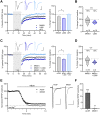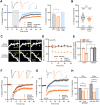d-Serine Inhibits Non-ionotropic NMDA Receptor Signaling
- PMID: 38942470
- PMCID: PMC11308331
- DOI: 10.1523/JNEUROSCI.0140-24.2024
d-Serine Inhibits Non-ionotropic NMDA Receptor Signaling
Abstract
NMDA-type glutamate receptors (NMDARs) are widely recognized as master regulators of synaptic plasticity, most notably for driving long-term changes in synapse size and strength that support learning. NMDARs are unique among neurotransmitter receptors in that they require binding of both neurotransmitter (glutamate) and co-agonist (e.g., d-serine) to open the receptor channel, which leads to the influx of calcium ions that drive synaptic plasticity. Over the past decade, evidence has accumulated that NMDARs also support synaptic plasticity via ion flux-independent (non-ionotropic) signaling upon the binding of glutamate in the absence of co-agonist, although conflicting results have led to significant controversy. Here, we hypothesized that a major source of contradictory results might be attributed to variable occupancy of the co-agonist binding site under different experimental conditions. To test this hypothesis, we manipulated co-agonist availability in acute hippocampal slices from mice of both sexes. We found that enzymatic scavenging of endogenous co-agonists enhanced the magnitude of long-term depression (LTD) induced by non-ionotropic NMDAR signaling in the presence of the NMDAR pore blocker MK801. Conversely, a saturating concentration of d-serine completely inhibited LTD and spine shrinkage induced by glutamate binding in the presence of MK801 or Mg2+ Using a Förster resonance energy transfer (FRET)-based assay in cultured neurons, we further found that d-serine completely blocked NMDA-induced conformational movements of the GluN1 cytoplasmic domains in the presence of MK801. Our results support a model in which d-serine availability serves to modulate NMDAR signaling and synaptic plasticity even when the NMDAR is blocked by magnesium.
Keywords: NMDA receptors; co-agonist; d-serine; dendritic spine plasticity; long-term depression; silent synapses.
Copyright © 2024 the authors.
Conflict of interest statement
The authors declare no competing financial interests
Figures





Update of
-
D-Serine inhibits non-ionotropic NMDA receptor signaling.bioRxiv [Preprint]. 2024 Jun 1:2024.05.29.596266. doi: 10.1101/2024.05.29.596266. bioRxiv. 2024. Update in: J Neurosci. 2024 Aug 7;44(32):e0140242024. doi: 10.1523/JNEUROSCI.0140-24.2024. PMID: 38854020 Free PMC article. Updated. Preprint.
References
-
- Aman TK, Maki BA, Ruffino TJ, Kasperek EM, Popescu GK (2014) Separate intramolecular targets for protein kinase a control N-methyl- d-aspartate receptor gating and Ca2 + permeability. J Biol Chem 289:18805–18817.
MeSH terms
Substances
Grants and funding
LinkOut - more resources
Full Text Sources
Molecular Biology Databases
Miscellaneous
